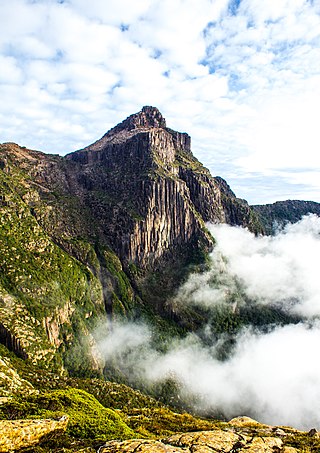
The Franklin River is a major perennial river located in the Central Highlands and western regions of Tasmania, Australia. The river is located in the Franklin-Gordon Wild Rivers National Park at the mid northern area of the Tasmanian Wilderness World Heritage Area. Its source is situated at the western edge of the Central Highlands and it flows west towards the West Coast.

Lake Pedder, once a glacial outwash lake, is a man-made impoundment and diversion lake located in the southwest of Tasmania, Australia. In addition to its natural catchment from the Frankland Range, the lake is formed by the 1972 damming of the Serpentine and Huon rivers by the Hydro Electric Commission of Tasmania for the purposes of hydroelectric power generation.

The Franklin Dam or Gordon-below-Franklin Dam project was a proposed dam on the Gordon River in Tasmania, Australia, that was never constructed. The movement that eventually led to the project's cancellation became one of the most significant environmental campaigns in Australian history.

The Gordon River is a major perennial river located in the central highlands, south-west, and western regions of Tasmania, Australia.

Peter Dombrovskis was an Australian photographer, known for his Tasmanian scenes. In 2003, he was posthumously inducted into the International Photography Hall of Fame, the first Australian photographer to achieve that honour.

Hydro Tasmania, known for most of its history as the Hydro-Electric Commission (HEC) or The Hydro, is the trading name of the Hydro-Electric Corporation, a Tasmanian Government business enterprise which is the predominant electricity generator in the state of Tasmania, Australia. The Hydro was originally oriented towards hydro-electricity, due to Tasmania's dramatic topography and relatively high rainfall in the central and western parts of the state. Today Hydro Tasmania operates thirty hydro-electric and one gas power station, and is a joint owner in three wind farms.

The Wilderness Society is an Australian, community-based, not-for-profit non-governmental environmental advocacy organisation.
The Tasmanian Wilderness Society was a Tasmanian environmental group that started in 1976 in response to a proposal by the state's Hydro Electric Commission to construct a dam on the Gordon River, downstream from the Franklin River, that led to the Franklin Dam controversy. The group evolved from membership of the South West Tasmania Action Committee and members of the United Tasmania Group. It was active in public protest about the issues of Wilderness, the Franklin River and South West Tasmania.

South West Tasmania is a region in Tasmania that has evoked curiosity as to its resources over the duration of European presence on the island.
The Gordon Splits is a notable section of gorges of the Gordon River, located in South West Tasmania, Australia. The once impassable gorges are situated on the lower Gordon River in the Franklin-Gordon Wild Rivers National Park, part of the Tasmanian Wilderness World Heritage Area. The splits has also been an important location of focus within the larger environmental campaign for wilderness preservation in South West Tasmania.

The Gordon Dam, also known as the Gordon River Dam, is a major gated double curvature concrete arch dam with a controlled spillway across the Gordon River, located in Southwest National Park, Tasmania, Australia. The impounded reservoir is called Lake Gordon.
The Serpentine River is a major perennial river located in the south-west and western regions of Tasmania, Australia.
The Edgar Dam is an earthfill embankment saddle dam without a spillway, located offstream in the South West region of Tasmania, Australia.
Brenda Hean (1910-1972) was a member of the Lake Pedder Action Committee (LPAC) and a resident of Hobart, Tasmania who disappeared at the time of the flooding of Lake Pedder.
The Lake Pedder Action Committee was a Tasmanian environmental group.
Olegas is an opera based on the life of Lithuanian-born Tasmanian wilderness photographer Olegas Truchanas. Music for the opera was composed by Constantine Koukias, Tasmanian composer and opera director of Greek ancestry based in Amsterdam, where he is known by his Greek name of Konstantin Koukias. The libretto was written by Natasha Cica.
This page discusses the rivers and hydrography of the state of Tasmania, Australia.

Tasmania's Wilderness Battles: A History is a 2008 book by environmentalist Greg Buckman, who has "spent [his life] fighting Tasmanian environmental battles." The book looks at the wilderness areas of Tasmania which have been the focus of extensive conflict over environmental issues. Buckman presents a record of some of the significant events in that conflict, primarily from the viewpoint of an environmentalist.
Pieman River Power Development was a major 1970s and 1980s hydroelectric development of the Pieman River and its tributaries on the west coast of Tasmania.
Max Rupert Angus, FRSA was an Australian painter, best known for his watercolour paintings of Tasmanian landscapes.








